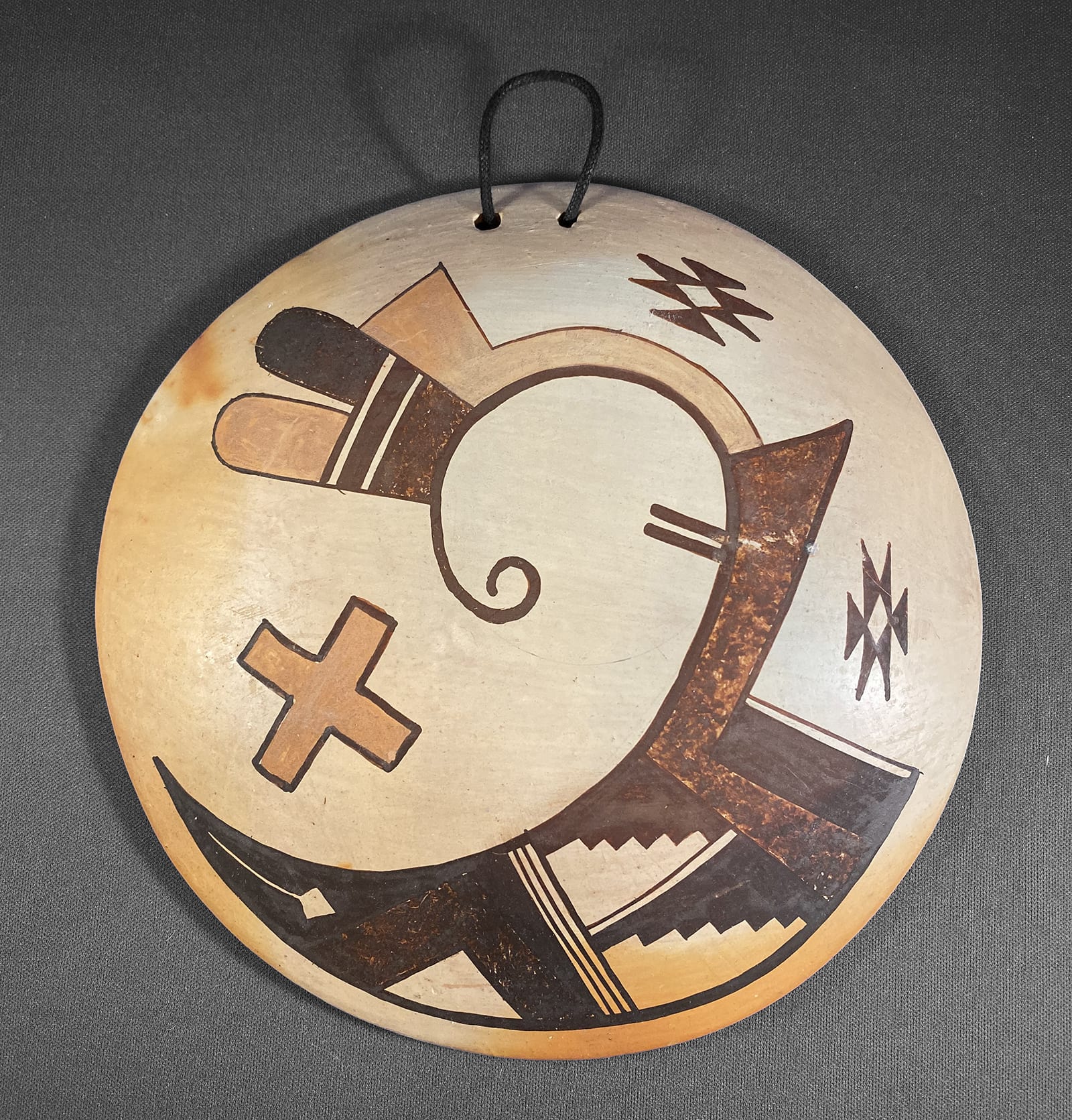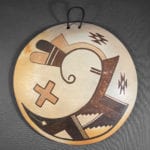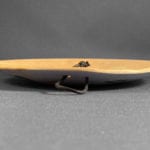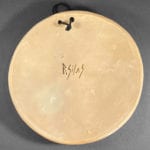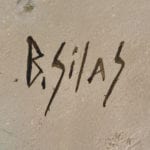Born in 1987, Bobby Silas was taught potting by a member of the Navasie family. According to Charles King, Bobby has been potting only four years and is intent on reviving Sikyatki pottery using local clay, tools and variations of the ancient designs. I believe he is the only potter at Hopi firing with local lignite coal, as was the prehistoric method.
Pot 2019-11 is in the form of a shallow bowl turned upside down and decorated on the convex surface. The concave side is only roughly smoothed and carries the potter’s signature. The decorated side was stone polished but striations and some imperfections show. Both sides are lightly blushed from the outdoor firing.
The central design is a deconstructed bird form with a large curved triangular head. Painted solid black, this form is inset with an unpainted arrow, presumably representing a mouth, and a large unpainted triangle, representing an eye. A narrow unpainted band incorporating four parallel lines follows. This “three-lane highway” then abuts a slightly trapezoidal central body section. The trapezoid is cut into upper and lower sections by a narrow unpainted band. Both upper and lower segments are further divided by diagonals with 5 or 6 steps. Thus the central body core has been subdivided into four areas. Working from the center to the rim these are colored solid red-maroon, unpainted, solid black and unpainted.
Abutting the trapezoid core is a hatchet-shaped form with a short shaft that is the width of the bird’s body and a longer rear-facing head the broadens out to a sloped edge. As is often true of prehistoric Sikyatki pottery, this form is inconsistently painted with a rusty-red paint, some areas splotchy and some stippled. Two parallel black lines emerge from the top edge of the hatchet head and reach toward the center of the clay disk. Beneath the crook of the hatchet and parallel to the handle is a wide vertical rectangle painted solid black, its right edge a thin unpainted stripe.
At this point the bird’s body narrows dramatically and becomes more abstracted. The framing line of the lightly-curved inner edge of the bird continues past the top edge of the hatchet and increases its curl exponentially, ending in a tight open curve. Along its outer edge is drawn in yellow a distorted version of the first hatchet, this one with a long shaft and ending in a short, upward-pointing head.
To the left of this yellow hatched head is another trapezoid, its narrow base on the framing curve, its wider side reaching for the far edge of the clay disk. The wider portion of this form is cut by two thin, unpainted stripes. The splotchy rust-red paint colors the base of the trapezoid; the area between the stripes is solid black. Sprouting from the top are two stubby feathers, the rightmost splotchy rust-red and the left yellow.
Orbiting around the central bird are three smaller designs. Two outside the tail of the bird are open stars, each formed from six small triangles with their points touching. This motif is commonly woven into Navaho rugs. In the space between the bird’s head and tail floats a stubby Crusader’s cross painted yellow.
The variation of shape, size and color make this a visually engaging design. It is innovative yet firmly rooted in pre-European Sikyatki design tradition. Apparently Bobby Silas is not trying to copy ancient Sikyatki pots but rather uses this heritage as an inspiration and technical guide for creating his own pots. In this he is like Michael Hawley except that Bobby is working within his own culture.
In 2019, Bobby commented on a website that “i make sikyatki yellow ware (Hopi) third mesa bacavi village” I assume that this describes the origin of plaque 2019-11. However, since making this plaque, Bobby has moved to Zuni and is no longer solely focused on using Hopi clay and coal firing, though he also continues these efforts [See 2022-13.]
His form and design can be rooted in ancient Hopi traditions (see 2020-07 and 2020-08), but he is now living at Zuni, using Zuni clay, and firing in an electric kiln. In 2021, judging from the pottery he sells through Charles King Galleries, he is still at Zuni and making pots that are Zuni in form and design and is firing in an electric kiln..

